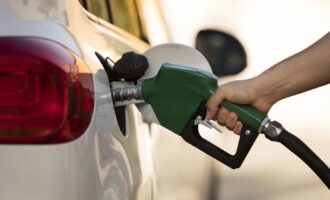Reformulating engine oils could have limited benefit in reducing CO2 emissions
By Aaron Stone
“Any commitment to reduce CO2 emissions from the 2020 target… can only be met through a rise in the market share of alternative powertrain cars.” This strong statement, from the European Automotive Manufacturers Association (ACEA) as part of a paper entitled “Tackling CO2 Emissions: An Overview,” implies that from 2020 onwards optimisation of the internal combustion engine (ICE) alone is not going to get us there.
Presenting at F+L Week 2017 on Reformulating Engine Oils to Meet the CO2 Challenge – A Narrowing Window of Opportunity, Petronas Lubricants International‘s Director, Research & Technology, Andrew Holmes, suggests we are faced with a “severe challenge to reduce emissions,” and that the opportunity for engine oils to make a dramatic new contribution is limited, with the automotive industry already looking to alternative solutions.
 Increasingly, worldwide governmental regulations requiring reductions in greenhouse gasses and emissions, with large financial penalties for non-compliance, are prompting significant change in vehicle technology. Holmes says some of this change is evolutionary — automotive OEMs optimising existing engine drivetrain technology, either through downsizing or new design features; the rest of the change is revolutionary. Certainly, OEMs are diverting increasing resources to new or alternative vehicle technologies to support these developments.
Increasingly, worldwide governmental regulations requiring reductions in greenhouse gasses and emissions, with large financial penalties for non-compliance, are prompting significant change in vehicle technology. Holmes says some of this change is evolutionary — automotive OEMs optimising existing engine drivetrain technology, either through downsizing or new design features; the rest of the change is revolutionary. Certainly, OEMs are diverting increasing resources to new or alternative vehicle technologies to support these developments.
More than USD100 billion is invested globally each year in automotive research and development, the equivalent of USD1,200 per vehicle. Indeed, we are beginning to witness key players make multi-billion dollar announcements in alternative powertrains, moving resources away from the ICE, signaling the increasing difficulty
of achieving incremental improvements in the combustion engine.
Leading the influx of announcements is Daimler, with a reported USD11 billion investment in alternative powertrains by 2025. Ford Motor Company has confirmed USD4.5 billion by 2020, and Toyota has created a separate new electric vehicle division in the company; these, alongside fuel cell and electric vehicle announcements from Honda, GM and Hitachi.
Despite widespread transfer of resources into this area, there remains tremendous diversity in forecast uptake of automotive vehicle powertrains. It’s impossible to locate a single forecast, or collective opinion, that provides any level of confidence we know where this industry is going. Holmes attests, there seem to be two extremes in forecast changes in powertrains, one that follows legislative or aspirational targets, and the other more conservative, following industry projections for substantive change through increasing electrification and the improvement of existing technologies.
Holmes believes “even allowing for a quickening pace of electric vehicle availability and adoption — change will still be a protracted process.”
When discussing the role of new vehicle technology in achieving emissions targets, automotive manufacturers are quick to stipulate that new vehicle technologies are only part of a bigger picture. Achieving success in the post 2020 emissions era requires a collective effort which includes a variety of inputs. Smarter transport infrastructure, retiring older vehicles from the global car parc, eco-friendly driving, evolution of alternate fuels, and connected cars all play a vital role.
Clearly, new vehicle technology will eventually yield a step change in emissions. However, according to Holmes, the relatively slow growth in alternative powertrains and fuels, and challenging emissions targets in 2020 and 2025 means the short to medium term solution to our emissions challenge is still the optimisation of the ICE. Alongside this are improvements in engine lubricants to reduce emissions through a variety of means.

Friction reduction strategies are a key component of optimising engine performance and, in particular, fuel economy. This approach has accelerated the adoption of 0WXX low viscosity lubricants, and is driving a requirement for high performing Group III+ and PAO base stocks to meet formulation challenges.
To complicate matters further, Group III+ and PAO base stocks are in short supply, with a limited number of suppliers worldwide. Despite investment plans and growing availability, it is a challenge already to supply the market. Holmes predicts strong demand for Group III+ and low viscosity PAO to 2020 and beyond.
Irrespective of their critical contribution to helping reduce global CO2 emissions, there may be a small window for new advancements in low viscosity and low volatility lubricants. Holmes questions how long the window of opportunity will remain open given developments diversion of OEM resources from the conventional ICE to alternative powertrains. There is no doubting that full scale electric vehicles have a very limited requirement for lubricants – and widespread adoption will ultimately deliver a dramatic impact on lubricant consumption patterns, although legacy vehicle requirements will persist for a protracted period.
To maximise the efficiency of the ICE and overcome key obstacles with today’s technology, Holmes suggests that strategic partnerships are essential in moving forward. He says “OEMs, Tier 1 suppliers and the lubricants industry must partner now to maximise the efficiency of the ICE,” asserting that the opportunity to reduce CO2 emissions can only happen by developing the chemistry, tribology and hardware in partnership. Although, he warns, we shouldn’t expect to see massive generational improvements in CO2 reduction in the engine to replicate developments over the last five to 10 years.







